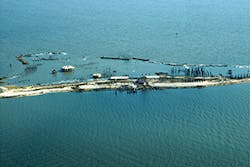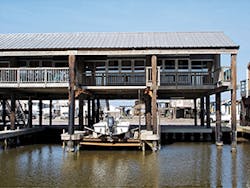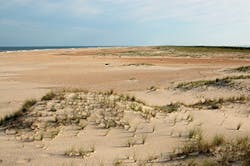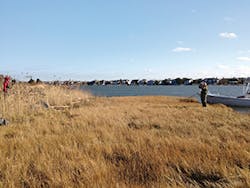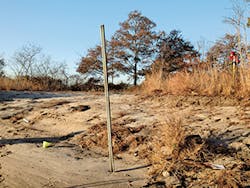Climate change, sea level rise, failing infrastructure, and challenged budgets are a recipe for disaster in the truest sense. However, while the fact of sea level rise is scientifically undisputed, it is a slow moving disaster. No one will wake up and find Miami or New York suddenly under water. Yet, it is because these are slowly encroaching changes—occurring over years, decades, and even centuries—that there is less sense of urgency for action. The regions at highest risk are also the most densely populated urban areas, and those populations are increasing as people are rediscovering the convenience and culture of city life with the proximity to water recreation.
But the majority of these US cities founded centuries ago in the Northeast, mid-Atlantic, Pacific, and Gulf coasts are built quite literally on shaky ground.
For years, the infrastructure in these regions has largely been addressed with short-term repairs. The threat of rising ocean waters on recently revitalized areas that bring needed tax dollars and a boost in local economies, has been the bigelephant in the middle of the room to think about, “someday.” But experts caution that someday is not only here now, it’s in the middle of the room waving a red flag for attention.
However, according to many researchers, sea level rise is not well understood as the contributing factors—climate, weather, human intervention, legacy issues, land mass shifts—create a composite of complex and confounding factors to address.
OLD RULES, NEW IDEAS
“We have two problems that occur in the coastal processes,” explains Kristina Hill, Ph.D., and associate professor at the University of California, Berkeley.
“Both sand and silt are in motion on the coast, and as sea level rises, these processes can accelerate. That sand and silt can be placed in new locations.”
She says while we typically expect beach profiles to move back, this “isn’t always what happens.
“There is an old idea, ‘Bruunes Rule,’ from the ’50s, that offers a relationship between sea level rise and shoreline retreat. This Rule says that if sea level rises one foot, the beach profile will retreat to move something 80 to 100 times the sea level. This doesn’t always work. What we’re actually seeing is that the beaches are eroded and the edge has moved inland. But the profile has not stayed the same and a shelf with a steeper-cut face forms.
“The Bruun Rule states that a typical concave-upward beach profile erodes sand from the beach face and deposits it offshore to maintain constant water depth,” she adds. “The rule can be applied to correlate sea level rise with eroding beaches and estimates the response of the shoreline profile to sea level rise.”
The rule, which has long been a staple of engineering applications, assumes an equilibrium shore face situation, but “it doesn’t account for changes in the amount of sand coming along the shore.” And, when shores are artificially managed, “all it takes is one marina entrance to cut off sediment supply to a beach,” and the predictive value of the rule is limited.
Sandy dunes eroded by the high tide, perhaps due to climate change, near Petten, Netherlands
SAND IS SAND, OR IS IT?
Another factor is sediment size. “Some beaches are nourished with particles that are bigger or smaller than in the past, and that will change how much is eroded and how much stays put,” says Hill.
This exact scenario has occurred in Cape Cod, which she says is not good news for protection. “Instead of keeping the same profile with the dune landscape intact, we’re seeing an erosional component.”
There are a lot of different conditions to consider in addressing sea rise; it’s not simply a rising sea water level. “Sand and silt is moving, it changes the stormwater outfalls,” she explains. “Some of these outfalls are right there, 100 feet off the beach. Then when these big plugs move, a lot of the outfalls need maintenance because the gates won’t open when tidally influenced. So, then you have these expenses.”
But there is a more compelling factor that Hill says people have forgotten about which alters their perspectives of the true picture.
DYNAMICS AFFECTING URBAN WATER SUPPLY
“Groundwater is a huge issue in this scenario,” she emphasizes. “The Dutch know all about it, being below sea level for millennia.”
So then, groundwater becomes yet another grievance to the burdens of coastal urban areas already facing the effect of failing infrastructures.
Many major cities are built on what were wetland areas, Hill says, and “Almost all of our cities expanded at low densities and they drained them with pipes. They created a preferred motion of pipes but with our penchant for deferred maintenance, these pipes are subject to infiltration, and we’re losing capacity to manage stormwater and drinking water.”
Hill points to the costly drama of leaking pipes where some coastal municipalities, like New Orleans, are “losing 50% of their drinking water due to leaks.
“This means they have to pump out their groundwater which is chlorinated, treated drinking water,” she adds. “This is an economic disaster no one can afford.”
She further illustrates the dynamics of the water table in coastal areas where the cities built on sand are at risk.
“When we put our pipes in we counted on the water table being low; we channelized rivers, we tried to move it and drain it out of the ‘sponge.’ So we made open voids of concrete lined channels and pipes, but now that sea water is rising, it’s pushing up groundwater, and those pipes can get filled and sewers can back up.”
What happens in this case is even though the stormwater pipes “appear to be functioning they aren’t because they are 90% full.”
Houses built high above the water in Cocodrie, Louisiana
HOW WATERS COMPETE
Groundwater is a saturated zone of soil—if there’s rain the level goes up, if not, it goes down but in areas of high infiltration rate, “like sand, it’s locally higher, when it [water] subsides, goes down quickly.”
“Now picture this, in low-lying areas we’re focused on the shoreline as the areas that are affected by flooding. But in rising sea levels, the flooding area is twice as large when you add in the freshwater groundwater flooding.” And in some regions, land is sinking as well.
“In areas of subsiding landmass, Norfolk, Virginia, for example, there’s a rising water table because there’s rising sea level; these are areas that are literally sinking.”
In Oakland, CA, which Hill says is “a city largely built on sand and an arm of an estuary, and they are constantly pumping groundwater out,” these “ghost saltwater wetlands,” as Hill calls them, are only too eager to return to their natural conditions.
“They’re all coming back, even the freshwater ones, and we’re seeing filled pipes, non-functioning sewer systems, and flooding.”
And ironically, in a perverse turn of events, the infiltration of unwanted legacy contaminants “that we so efficiently did all that work on to cap from above so rainwater wouldn’t mobilize those solids, are now migrating from below.”
She continues, saying, “These [sites are] capped but not lined, so they can remobilize into our water supply,” creating yet another unanticipated effect of groundwater. All of these issues make the freshwater flooding “a complicated three-dimensional problem that we just have to get started on.
“Our stormwater pipes are reducing the groundwater level; it’s lower where there are pipes installed, then it gets in the pipes, then as those fill, the groundwater rises around those pipes.”
UTILITIES CAN SPRINGBOARD SOLUTIONS
Hill says groundwater is the most important piece of this coastal drama, but there are strategies to tackle these chaotic hydrological curve balls Mother Nature is throwing at us.
She advises use of 3D maps which illustrate more than just a projected rise in sea level, but are the true picture of the dynamics of groundwater, rising water table, sinking landmass, and the effect that rising saltwater has on driving up the freshwater levels.
Hill cites one example from the city of Honolulu, HI, where “freshwater flooding occurred across twice the area as that of saltwater flooding.
“What is needed are monitors in our stormwater system that can measure and track the Infiltration and Inflow [INI] which tells us about the water table, especially pairing the intensity of INI with a storm event,” says Hill, adding that utilities could be the heroes in this effort.
“If they get in the picture early they can play a valuable role to implement monitoring programs. This is not a well-known problem, but coastal cities could potentially get funding on the premise that monitoring stormwater tells us what is happening underground that we can’t see until it’s too late, and we’re then faced with flooding.
“We have to support investments by acting sooner rather than later, and states and municipalities face competing demands for funds,” she adds.
Hill explains that strong data from monitoring can be leveraged by utilities and help put them at the front of the appropriations request line.
One solution would be to adopt technology from the Dutch, “the people who best manage the groundwater table,” whose very successful tactic is a shrink-wrap product on the inside of pipes, she says.
“This is their standard protocol, and it is a relatively inexpensive technology. Plus, it is non-toxic, so we could do that here, knowing our water supply would remain safe without chemicals leaching from a repair intervention.”
Instead of rebuilding older failing infrastructures, these liners could be answer to waterproofing the systems.
In any event, Hill cautions that left unchecked, “Our sewage system and parts of our urban infrastructure areas will fail; this means it’s unsanitary, and we need to be prepared for this to happen.”
AND YET ANOTHER CURVEBALL
While global warming and groundwater contribute to the sea level rise issue, Jennifer Irish, Ph.D., P.E., D.CE, associate professor Department of Civil and Environmental Engineering, Virginia Tech in Blacksburg, VA, says there are other considerations.
“Interventions that disturb the ground, such as oil, gas, and water extraction, as well as natural phenomena like tectonic changes, can affect the local ground elevation and locally accelerate sea level rise.”
Irish says land is sinking in the coastal areas, and like Hill, cites the eastern shore of Virginia—the Norfolk/Hampton Roads areas, where the landscape is particularly vulnerable to changes that accelerate the process of beach and shoreline erosion. And she adds storm surge as yet another component.
Irish has been studying storm surge from hurricanes and incorporating the dynamics of sea level rise to advance the understanding and predictive modeling techniques for short- and long-term climate trends.
“Areas that are prone to high storm surge are those that are the more flat, coastal areas,” says Irish. “Not everywhere has the same potential to have large storm surge. However, if we take sea level and add that to today’s storm surge without considering it dynamically, that could potentially under or overestimate the actual acceleration in flooding that might occur.”
Her research reports that rising sea levels can affect storm surge generation “by altering shallow water depths and distances, and land cover.”
For example, the open coast regions near New Orleans today are more vulnerable to storm surge inundation, and this corresponds directly to coastal wetland losses from the encroaching sea level rise.
What happens, she describes, is the conversion of marshlands to open water, which reduces bottom friction and offers a broader distance over which high storm or hurricane winds can pick up more water, drive it inland, and increase the flooding.
But Irish adds there is a counterintuitive side as well. Loss of vegetation and deeper depths accompanying sea level rise in some areas could dampen the influence of storm surge; while flooding will certainly be worse with sea level rise, some areas may be less impacted than others because local surge generation is reduced.
While Irish’s studies focus primarily on surge from hurricane activity to develop accurate risk and hazard assessments for areas at risk, the studies clearly illustrate the role of sea level rise as it influences total flood elevation and surge generation. “We really have to understand the composite picture; there is very large uncertainty. And we need science to guide ourdecisions.”
But this poses challenges for municipalities. “Doing everything possible to protect against the worst case scenario could be as imprudent as doing nothing,” she says. “You have to invest in options that regardless of where the future falls on the spectrum of possibilities, it will be a good and positive change. If you overspend or underspend you can put your community at risk.”
Irish observes that some vulnerable areas, particularly small coastal towns with fewer resources, will have hard decisions to make. Those communities with low economic base that are at risk may have to consider relocation, something to think about now, rather than later.
Relocating communities cannot be ignored, and civil decisions such as not improving a roadway because it may be underwater in the future smacks of exclusion and abandonment. But Irish advises local and state civic leaders to rally public participation with scientific climate leaders, not-for-profit advocacy groups, sympathetic policymakers, and supporting academic experts. Together, they have a better chance to find answers and exert positive cases to influence sources of funding and either retain their lifestyle and maintain their existence, or transition to new areas. In all cases, Irish says, having an adaptive but flexible strategy is essential.
“We really don’t know what’s going to happen with sea level rise. We have estimates but don’t know the actual timing and in which trajectory it will occur, but it’s important to have broad community input from a wide spectrum of individuals, groups, and local officials. The social investment in any plan cannot be overstated.
“Once sea level rises, it’s here; and it’s here to stay, and we can’t ignore that.”
Sea-level causes overwash on island beaches, such as on Assateague Island, Maryland
HELP FOR HARD DECISIONS
For municipalities who cannot visit the Netherlands to experience the innovative technologies first hand, there is help on this side of the Atlantic. Mike Schmidt, senior water resource strategy planner of CDM Smith Inc., a Boston-based engineering and construction firm, says that his company’s mission is to offer clients innovation in flood risk reduction, mitigation, and resilience from planning through design and construction including “alternative delivery approaches for environmental and infrastructure projects.”
His broad-based experience from more than 190 programs across 30 states including Florida—a state with multiple fresh and seawater challenges—addresses stormwater planning and the modeling and flood control in concert with water quality retrofits and ecosystem restoration.
“We’re a global firm of more than 5,000 professionals around the world with a focus on water, environment, transportation, energy, and facilities. However, water is really our heart and soul, and the core of our business. We’re focused on areas such as developing resilient projects for stormwater management, flood control, ecosystem restoration, and water quality; smarter infrastructure; innovation in for water supply; and innovation with net zero technology to reuse “wastewater” and beneficially use biosolids for fertilizer and energy.”
He adds that his company’s most relevant emphasis is on “developing and building more resilient features” for all water facilities—stormwater, drinking water, and wastewater.
Innundation lines on the shore of Barnegat Bay, NJ, following Hurricane Sandy
Schmidt reviews the growth of green infrastructure, which he recalls was gaining popularity as far back as the mid 1980s, especially in Florida. For stormwater and ecosystem projects, CDM Smith “uses more green than grey, although sometimes you just have to use concrete and steel.”
“Since the Clean Water Act (CWA) in the 1970s, it’s been the challenge of our generation to address water quality. Now, with climate change and rising sea levels, the challenge for this generation is to create and implement strategies to cope with issues of sea level rise.” Most of the world’s most populous cities are near the coasts.
Schmidt explains that for coastal projects, CDM uses a 3-pronged approach: first is armoring, both green and grey infrastructure; second, raising some of the critical infrastructure such as pump stations, treatment facilities, emergency facilities, and evacuation routes. This step may then affect businesses and communities and make the third prong necessary: relocating at risk infrastructure and citizens that cannot be cost-effectively flood protected.
“Sometimes you just have to face the reality that infrastructure, and the business and residential community dependent upon that infrastructure, simply cannot be cost-effectively protected as water levels raise. If you have to raise a road, the merchants, hotels, and others alongside the road may no longer be accessible, and this becomes a logistics strategy of relocating.”
Innundation lines on the shore of Barnegat Bay, NJ, following Hurricane Sandy
MANAGING THE GREAT INTRUDER
In terms of stormwater, the challenges for many coastal areas on the eastern and gulf coasts of the US are that many of the outfalls go into the sea and they are submerged. This saltwater intrusion is more than an inconvenience.
“In southeast Florida and Miami, for example, the main evacuation routes can be routinely flooded even in a non-hurricane, sometimes by tidal backflow into the system on sunny days,” says Schmidt. “We’ve been working on implementing backflow devices with low headloss but the most efficient ones still have 2 to 6 inches of headloss.”
Schmidt explains that headloss is the amount of energy needed to move a liquid through a pipe to overcome friction and other hydraulic losses, including the submergence of the outfalls. Friction, such as a curve, a bend, or anything less than a straight delivery, slows up the process. Installing devices that efficiently push water out to help prevent backing up is essential to prevent seawater from competing with the exiting freshwater.
DOING MORE THAN RAISING SEAWALLS
Today’s interest to live near or in the largest cities situated on coasts, is currently the old real estate guidance of “location, location.” But over history, Schmidt points out that many cities were founded near coasts and rivers for “access and navigation” and these often grew into the adjacent wetlands and floodplains like portions of South Florida, New Orleans, and Bangkok.
As New York City, Miami, and New Orleans and other regions were first developed, it was for efficient shipping and trade purposes. The cities grew and the infrastructure developed.
“But no one would have ever imagined the populations would swell to the multi-millions of today, and since we can’t pick up and move these cities, we have to develop appropriate climate change adaptive strategies.”
But simply raising seawalls around major metropolitan areas like Miami isn’t the answer. “The data on Miami shows an acceleration of sea level rise but communities need to think outside the box to control water quality and recharge aquifers that are challenged by saltwater intrusion. One approach is to integrate water resource programs and treat stormwater as a water resource, as sea levels rise. Maybe the first floor of your parking garage will be a stormwater storage site, or, you could turn main streets into canals.
“You have to plan for the future and expect sea levels will be rising so you can control your destiny. The more proactive you are the less reactive you will need to be.”
By shifting perspectives and developing lower headloss technologies, more flexible and green floodwalls, storing stormwater in ecosystems, and restoring wetlands, Schmidt envisions the potential for stormwater to become a valuable asset, rather than an expensive management inconvenience.
“Every drop of water should count,” he says.
Stormwater pond and gazebo for a retrofit at Boynton Beach, FL
TWO PATHS, TWO DEFINITIONS
In the face of climate change and sea level rise, one scientist suggests that “There are two broad paths humanity can go down,” but Reinhard Flick, Ph.D., at University of California, San Diego, wants all coastal stakeholders to first make the distinction and understand the difference between “flooding” and “inundation” when planning. “Interchangeable use has confused people but there is clearly significant difference.”
“Flooding is when dry areas become wet temporarily—either periodically or episodically—but inundation denotes the process of a dry area being permanently drowned or submerged.”
He adds that while flooding is always higher than inundation and has long been dominant along open coasts, “Inundation is likely to become ever more important in the coming decades and may eventually become a dominant physical coastal process.”
Of the two paths to follow, Flick says one is mitigation. For example, this might include strategies that “limit and reduce greenhouse gas,” but he believes “by the time these measures are adequately recognized and supported by governments, despite well-intentioned efforts, it may already be too late.”
The second path is adaptation. Recognizing that “bad things may happen but [that] in the meantime we should plan to adapt, retreat, build higher, widen beaches, and protect critical sites or some combination.” Flick believes the first is reactive and preferred to avoid the worst of climate change, while the second is reactive but will also be necessary.
Flick’s advice is that municipalities get serious about this as a very real, and unavoidable threat to their communities and lifestyle. “In these last few decades before things accelerate, municipalities should inventory what they have. Find out what is exposed and perform a vulnerability analysis. Go out there with your local agencies and utility departments and find out, for example, what elevation of exposed electrical boxes, power plants, treatment plants, railroads, and roads are at risk. How are outfalls exposed to intrusion?
“When Sandy hit, a lot of the electrical boxes in the New York subways were not waterproof,” he adds. “And, you’d be surprised that people still reference standard elevation maps and feel safe in their planning, but these are often wrong. Some are inaccurate by as much as a foot.”
Now with GPS, Flick says we can measure elevation within millimeters. “Assume your sea level will go up and try different scenarios. What is underwater, what will be underwater with tides, how high does the total water level have to get when your electrical boxes are under water, for example?”
And current flood modeling techniques are another problem that Flick says can be misleading. “The standard bathtub models that indicate elevations and are predictive of how high water get can impart an artificial sense of confidence if they are used for development and planning. This is not how sea level rise works, especially in urban areas. True flood modeling takes into account that tides are only high for a few hours, and once tide drops, floodwaters recede. But then there is the groundwater level to consider which is pushed up by seawater, particularly in areas of porous limestone where seawater flows. And other technical details, like how water actually flows along streets and around buildings.”
SAVED BY INGENUITY
The good news is that while the population has changed and increased, so has our resourcefulness. “If you think about standing in New York in 1715, you couldn’t possibly imagine New York today. More than 300 years later, the differences in population and growth also reflect what was done with innovation and technology to adapt to that essentially small space.”
Flick believes human ingenuity is our best asset. “One thing that could save us in the nick of time is if we could find a way to perform sequestration, and capture CO2 right at the smokestacks of the gas and coal fired power plants, or pull it out of the air. Capture it, put it in the ground, so it stays there and do it affordably.”
He recalls, “When all jet traffic was grounded after 911, in just those few days we know the earth warmed up in absence of fewer contrails. We know that there is a changing chemistry of the atmosphere.” Nonetheless, Flick is optimistic that breaking old models and trying new approaches will be the direction toward tactics that help maintain our cities and coastlines.
And other experts concur with ingenuity-driven solutions. Hill says that green solutions are cheaper and provide multiple benefits to lower costs such as using swales, and improving wetlands to improve water quality. Creating and managing water by creating raingardens and wetlands right in the city, for example, are solutions all can appreciate.
“These help improve water quality, provide recreation for people and a habitat for wildlife. This is a win all around, and people like it,” she says.
PRESSING THE CASE FOR NOW, NOT LATER
For vulnerable coastal areas at risk, the issues are multiple—rising sea levels, changes in landmass, and rising groundwater. Add the effects of weather events from hurricanes, tropical storms, storm surge, and tides, and the challenge of sea level rise becomes much more complex, taxing lean budgets and aging infrastructures as never before.
Yet, while a hurricane disaster comes and goes, and heroes are recognized, the nature of sea level rise is slow, insidious, and permanent. All experts agree it demands bold actions now, but these measures will probably outlive the planners. No civic plaques, political favors, or celebrity awards will reward those whose efforts today may be best realized decades after the fact. But the cost of doing nothing will be very high, and no amount of heroics can save the effect of inaction.
When Did the Lightbulb Go On?
Sea level rise has been studied for 100+ years or 20, depending on who you ask. According to spokesperson Alan D. Buis of NASA’s Jet Propulsion Laboratory, oceanographers did not have much interest in sea level rise—whether regional or global—until a few decades ago, and interest started in earnest only 20 years ago with satellite altimetry data. Most older work was done by geologists who were looking at marine sediment in coastal regions. While that signal can be ocean going up or land going down (or the opposites), geologists made pretty good inferences regarding ice ages. However, while tide gauges on coastal regions have been measuring sea level over the last century this was intended to help navigation, and it was only in the 1950s that Patullo and Munk began to study the seasonal cycle of sea level in tidal gauges. So, sea level rise has been studied a long time if you ask a geologist, but ask an oceanographer and it is a recent pursuit.
Space-Age Technology for Modeling
NASA scientists studying sea levels recently announced a new model that makes major inroads to understanding the relationship of ice, oceans, atmosphere, and solid Earth and their interacting effects upon rising sea levels. In March of this year, scientists from NASA’s Sea Level Change team announced a new computer modeling method, “that for the first time allows researchers to weave high-resolution models of changes in individual glaciers into global models of relative sea level and solid Earth deformation, with great numerical accuracy and computational efficiency.”
The team says that ice mass changes leave marks on the Earth’s gravitational and rotational fields, a phenomena that generates “sea level fingerprints,” which allow for making precise, localized sea level forecasts.
NASA news author Pat Brennan, of the Jet Propulsion Laboratory, reports that, “One of the most fascinating and counter-intuitive features of these fingerprints is that sea level drops in the vicinity of a melting glacier, instead of rising as might be expected.”
The loss of ice mass reduces its gravitational attraction. Ocean water, no longer under its influence, migrates away. But far from the glacier, the water it has added to the ocean causes sea level to rise at a much greater rate.
With the new method, the loss of mass from a particular Antarctic outlet glacier, for example, could be tied directly to a sea level record at any tide gauge station around the globe. The team further adds that while most of the world’s glaciers are melting, the distinction must be made between glacial discharge into the oceans, which is more permanent, and the changes in precipitation and evaporation feeding glaciers and ice sheets, which “fluctuate on the scale of decades.”
So What Exactly Is Saltwater Intrusion?
According to the Atlantic Climate Adaptation Solutions Association, saltwater intrusion occurs in tandem with groundwater, precipitation, and other influences. While it occurs naturally in many areas, it can become problematic in a variety of circumstances.
One is when groundwater is withdrawn (pumped) from the aquifer, which reduces the hydraulic head in the aquifer, and this will then slow down or even stop the natural seaward flow of freshwater. Saltwater then moves further inland.
In another scenario, the excessive pumping of groundwater can also induce saltwater intrusion through “upconing.” This phenomenon occurs when deeper saline waters from the underlying saltwater wedge are drawn toward a pumping well, so then you have saline and fresh water mixing. In both scenarios the freshwater becomes contaminated and is no longer viable as a source of drinking water.
But there are other changes, such as reduced recharge from less precipitation, or increased sea level, that can cause a similar landward shift in the location of the saltwater-freshwater interface. Both of these can increase the risk of saltwater intrusion and play havoc with a community’s source of water.
